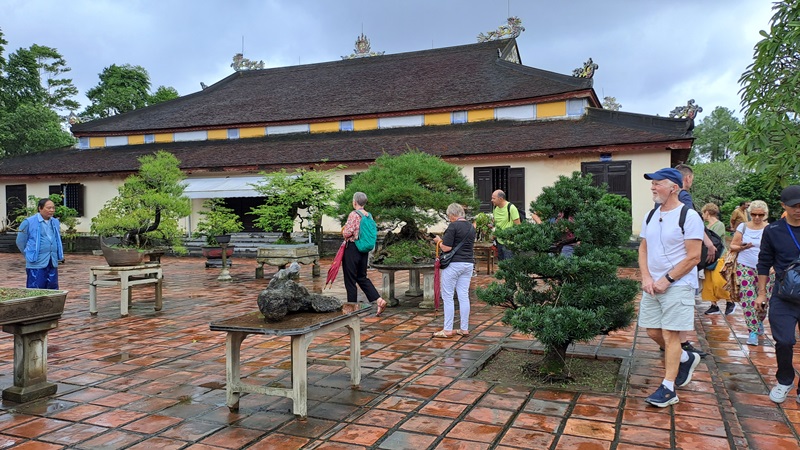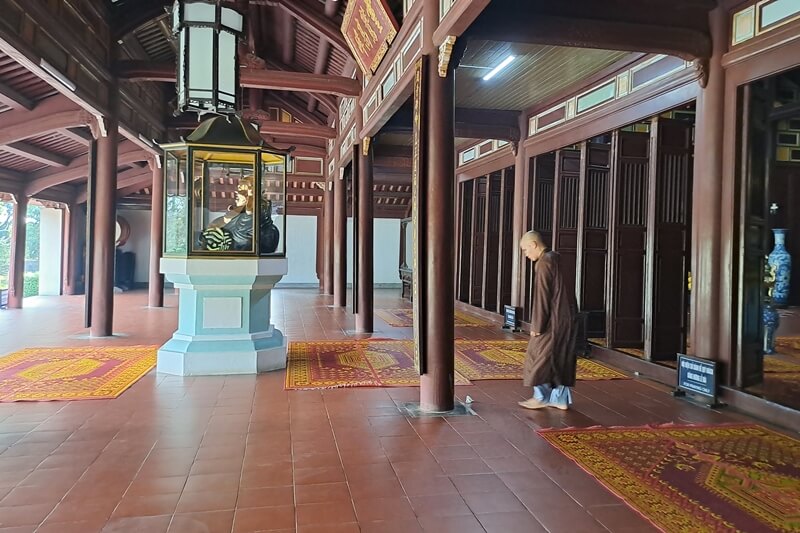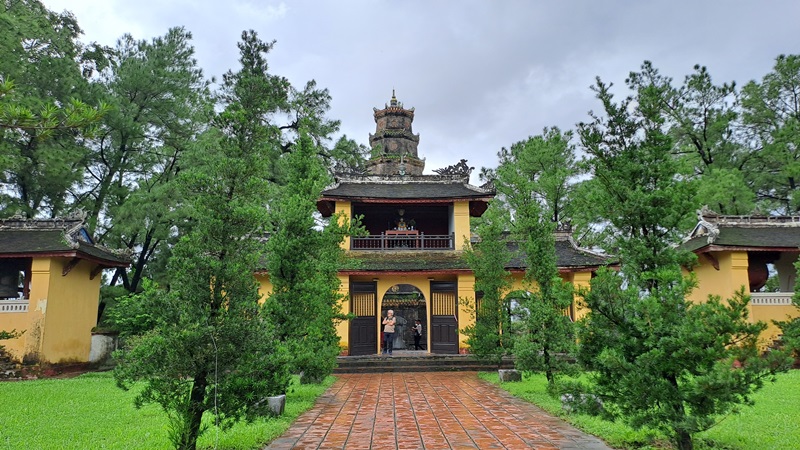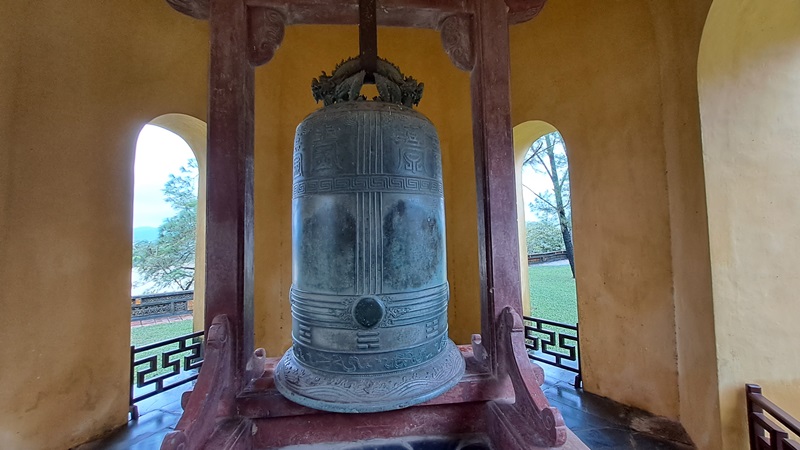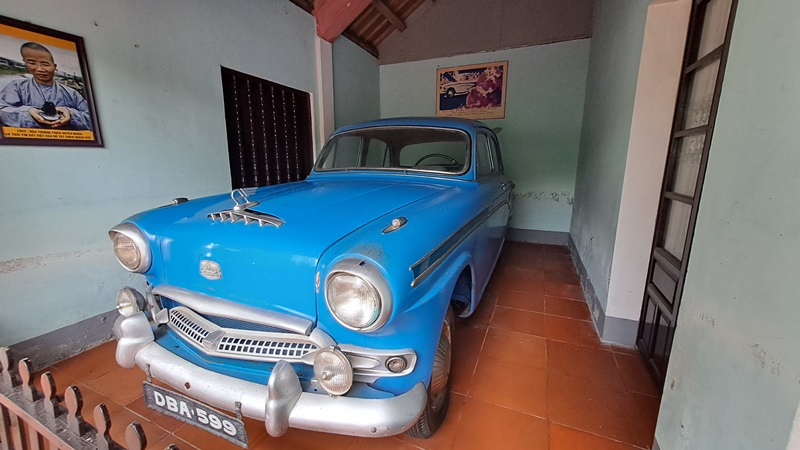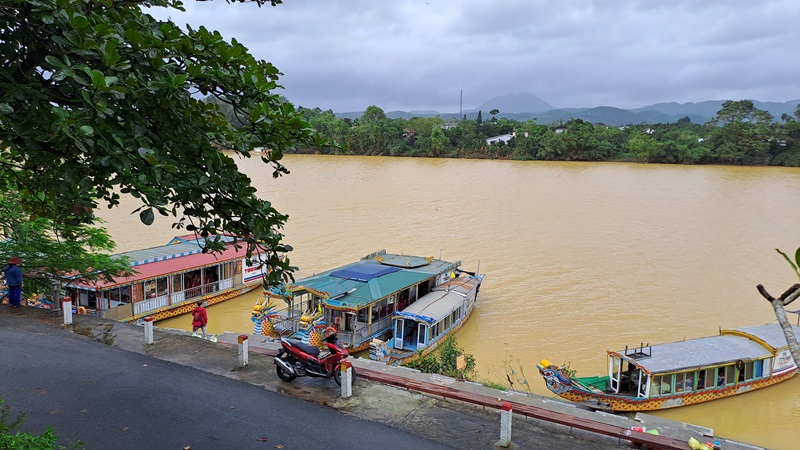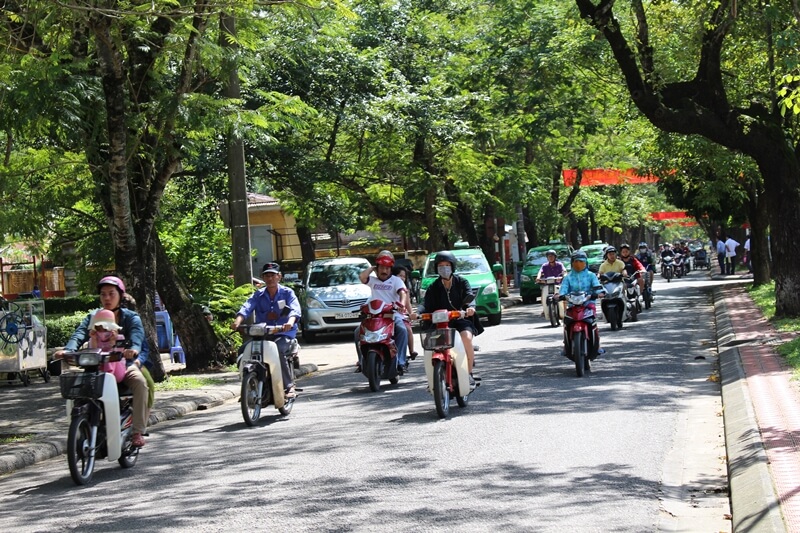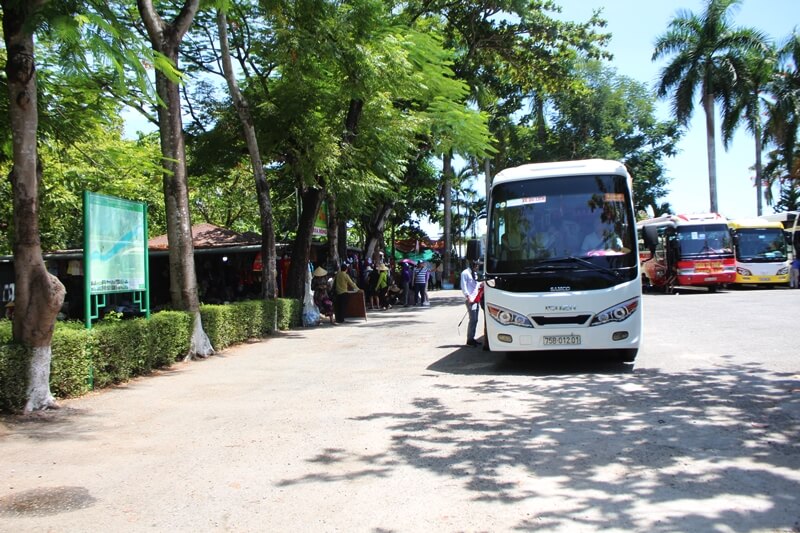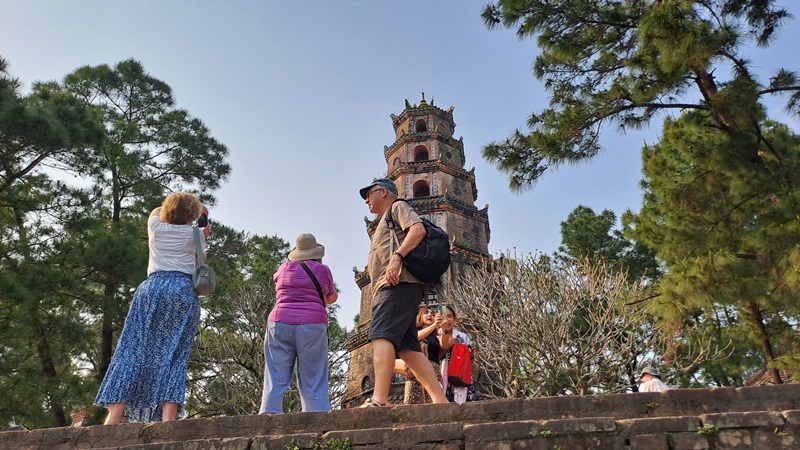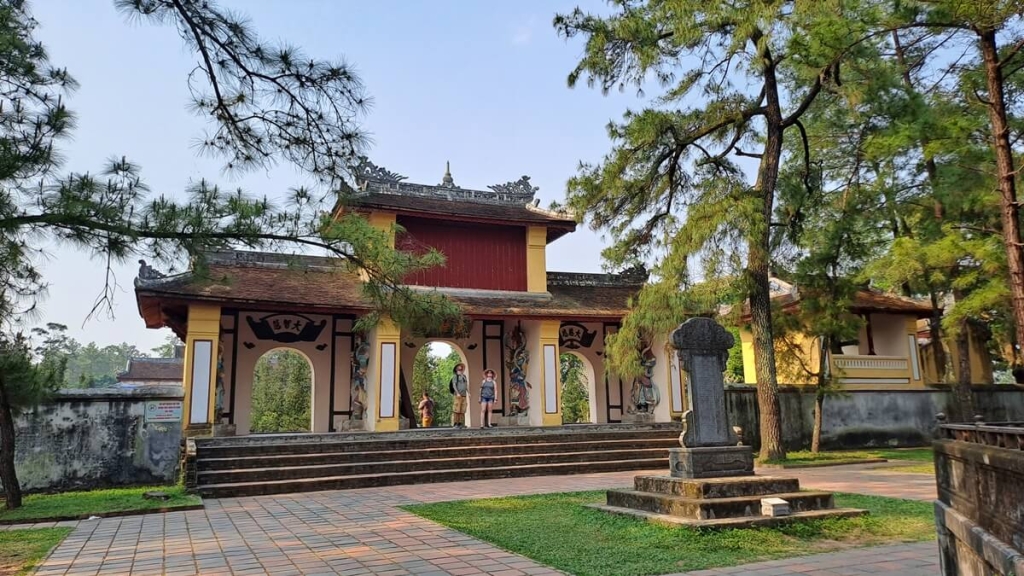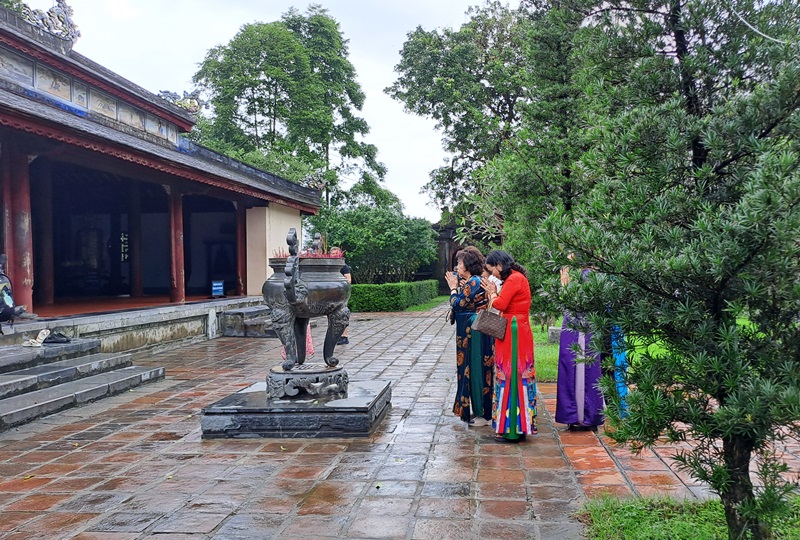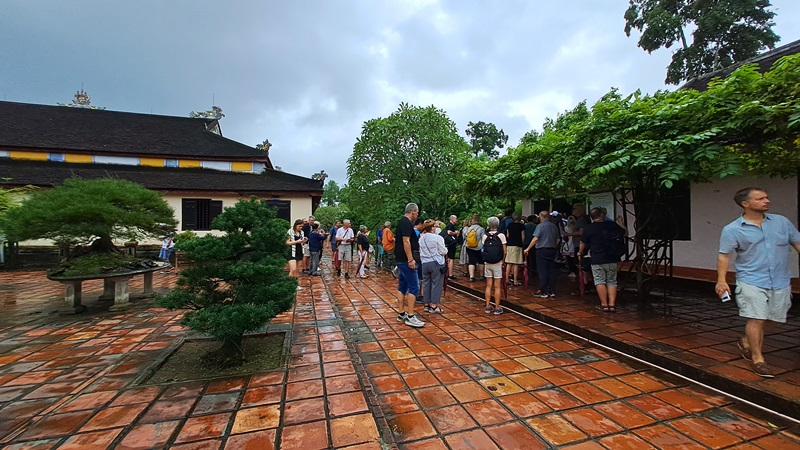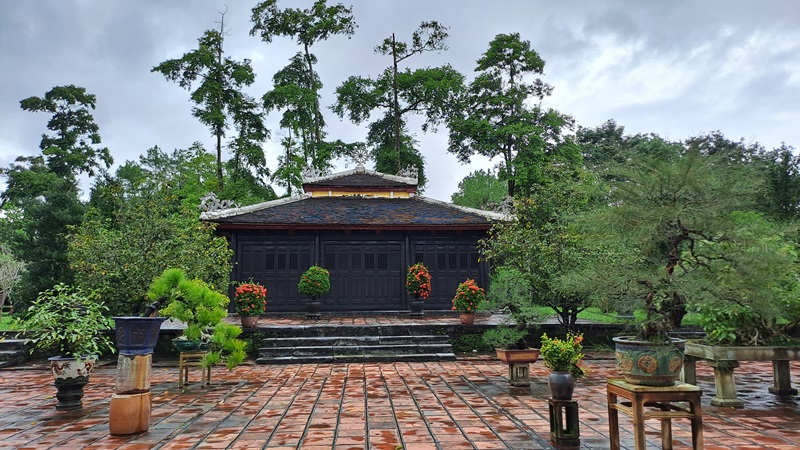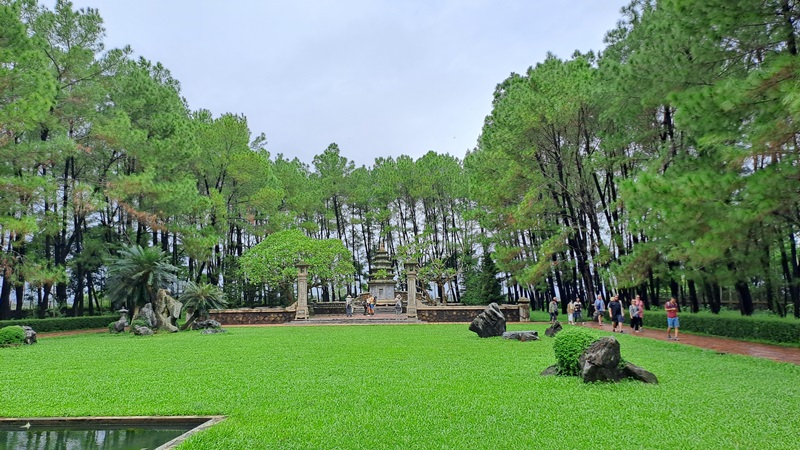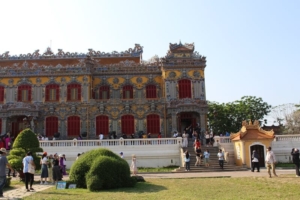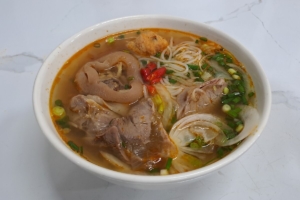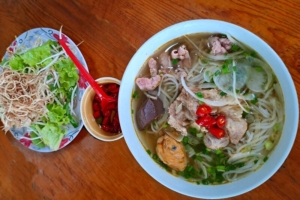Thien Mu Pagoda, also known as Linh Mu Pagoda, is located 5km west of Hue city center. It is on a hill with a hidden dragon position, facing the north bank of the Perfume River. This place has all the favorable feng shui elements for the development of Buddhism and the practice of Buddhist culture.
1. General information of Thien Mu Pagoda
- Address: Ha Khue hill, Huong Hoa commune, Hue city, Thua Thien Hue province, Vietnam
- Opening time: 5:00 am – 6:00 pm for surrounding area. The main temple is closed at lunchtime.
- Entrance fee: No ticktets.
For easy positioning, you can find the temple address on Google Maps, located at Nguyen Phuc Nguyen Street (Hue City, Thua Thien Hue, Vietnam).
2. The legend of Thien Mu Pagoda
In the past, the Ha Khue hill area was quite densely wooded. On the hill was a small temple that served as a sacred place of worship for local people.
In 1601, when Lord Nguyen Hoang traveled from the North to the region of Phu Xuan (Thua Thien Hue today) to find a place to set up his capital and build a fortune, he stopped to rest in this Ha Khe hill area.
While resting here, Nguyen Hoang had a dream. In his dream, he saw a woman wearing a red shirt and blue pants standing on the hill and said, “There must be a lord to build a pagoda here to collect sacred energy to maintain the dragon line. Just hold incense sticks and walk along the riverbank until the incense burns out. That is the place where the capital is”.
After waking up, Nguyen Hoang followed the woman’s instructions in the dream. The lord found for himself a favorable land to establish a capital. That is the Imperial Citadel area that still exists today.
At the same time, right after that, Lord Nguyen Hoang expanded the entire Ha Khe hill and built a spacious pagoda as a region to worship Buddha. Initially, it was named Thien Mu, meaning “Heavenly Lady”. During the reign of King Tu Duc, for fear of the word “Thien” violating the heavenly majesty, the temple was renamed “Linh Mu” (Holy Lady).
Today, two names Thien Mu and Linh Mu are popular among the locals. Over time, the temple has existed in the hearts of the Hue people as a sacred place to offer incense to Buddha, pray for peace in the country and life, and the best things for family and relatives.
3. Three special features at Thien Mu Pagoda
Thien Mu Pagoda is large, including various buildings and many beautiful spots waiting for you to explore. Among them, there are 3 typical features that you may be interested in:
3.1. The bell of Linh Mu Pagoda that can not ring
On the left side of Phuoc Duyen Tower is a small tower, and inside is preserved the treasure Dai Hong Bell (Great Bell). Dai Hong Chung was cast in 1710, during the reign of Lord Nguyen Phuc Chu. The bell weighs more than 2000kg, is 2.5m high, has a mouth diameter of 1.4m, and many exquisite patterns are engraved on the body.
The unique thing is that although this big bell has many cultural and historical values, it cannot ring. Its resounding sounds have stopped for a long time, but the bell still stays here.
Legend tells that, in the past, Dai Hong Chung rang very loudly, echoing very far every early morning. However, one day, a couple fortuitously hid themselves under the bell and showed their love for each other. From then on, the bell suddenly stopped ringing. However, the bell is still a meaningful treasure associated with the temple’s history.
3.2. Old Austin car
The classic Austin car displayed at Thien Mu Pagoda has great historical, cultural, and religious significance. In 1963, Venerable Thich Quang Duc used this antique car to the intersection of Le Van Duyet and Phan Dinh Phung in Saigon (now the connection of Cach Mang Thang Tam and Nguyen Dinh Chieu, District 3, HCM City). Then, he burned himself in protest of the Ngo Dinh Diem government’s policy of suppressing Buddhism.
Although, initially, Venerable Thich Quang Duc and this ancient Austin did not belong to Thien Mu Pagoda. But it is because Hue City is the Buddhist center of the whole country, and Thien Mu is a typical pagoda with a rich history. Therefore, the car associated with this marked historical event was displayed at this temple.
The principal purpose is for Buddhists to know and remember the sacrifice and desire of Venerable Thich Quang Duc for freedom of Buddhism in their lives.
3.3. Golden Buddha statue on top of Phuoc Duyen tower
As soon as you enter the pagoda area, the first impressive building that catches your eye is the seven-story tower called Phuoc Duyen Tower. Most tourists take the opportunity to take souvenir pictures around the foot of this tower.
The unique thing is on the top floor of the building, where a golden Buddha statue was kept. However, this vital statue is no longer there; no one knows where it is.
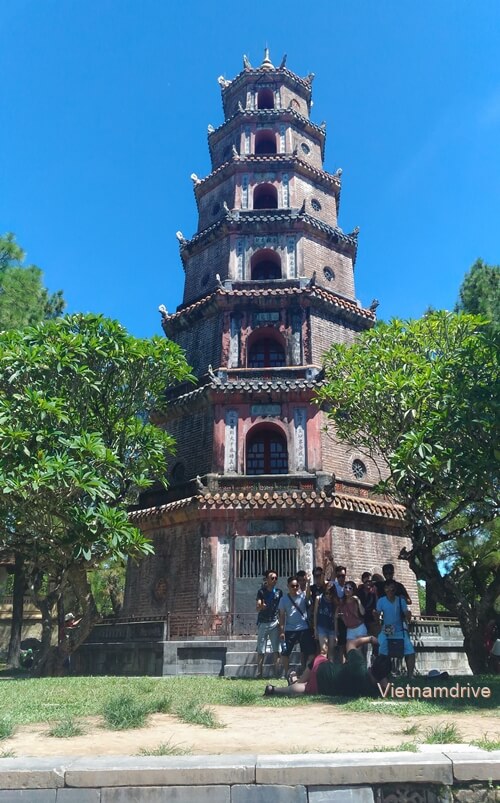
In addition, the gate to the tower is usually closed. Therefore, very few people are lucky to set foot in the stupa. That is also the reason why many visitors imagine mysterious things still hidden on the top floor of Phuoc Duyen Tower.
>> You may want to see Huyen Khong Son Thuong Pagoda.
4. Architecture of Thien Mu Pagoda
Thien Mu Pagoda was built in the architectural style of I ( – ). That means all the main architectural works, such as the four pillars, Huong Nguyen Communal House, Phuoc Duyen Tower, Tam Quan Gate, Dai Hung Bao Dien, Dia Tang Temple, Quan Am Temple, and the Great Ancestor Tower, were built along a straight axis from the front to behind, balanced and clear layout.
The four pillars in front of the pagoda are designed to create an airy path. The nice thing is that the design of these four pillars does not have a roof, creating a feeling of heaven and earth interacting, bringing closeness and friendliness to everyone when visiting the temple.
The roof of the temple buildings is decorated with dragons and reincarnation circles. The dragon images are simple, not too elaborate like the dragons on the royal palaces in the Citadel or the mausoleums of the Nguyen kings.
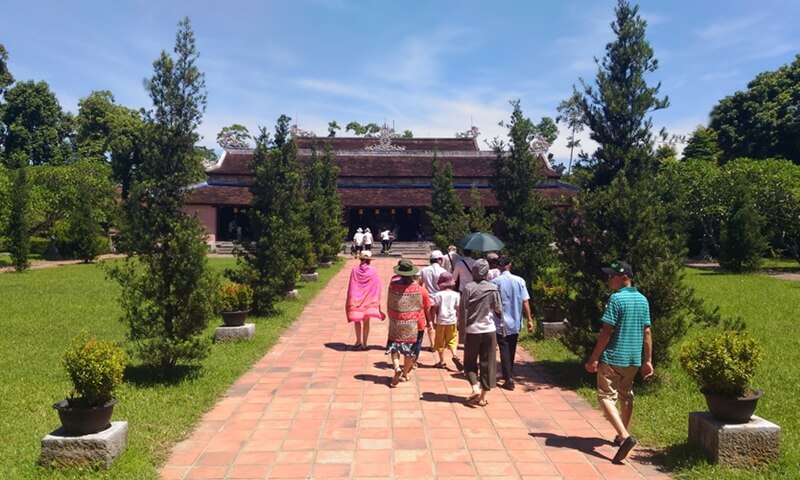
5. Guide to visiting Thien Mu Pagoda
5.1. The way to the temple
There are different options for how to get to Thien Mu Pagoda, including waterway and road.
Waterway:
From Toa Kham Wharf, located right next to the Perfume River floating restaurant, catch a dragon boat to head upstream for a journey to enjoy the Perfume River and visit Thien Mu Pagoda.
If the number of people in your group is less than 8, you can choose a single boat for a cheaper price. For 8 people or more, you book a spacious double boat for comfort and safety.
The price of each type of boat varies a lot. Each single boat trip costs 300,000 VND, while the double-boat price is 600,000 VND to 700,000 VND for one way.
However, the rate is for reference only because, at different periods, the price is not the same. In particular, if it falls at the right time of the festival at Hon Chen Temple, the boat price can double.
Road:
The road is the preferred choice of most tourists if only to visit Linh Mu Pagoda because it is easy, fast, and economical.
You can rent a bicycle or motorbike in the center of Hue city or book a taxi or private car service.
If you ride a bicycle, the road close to the banks of the Perfume River, through the parks, can be considered the most beautiful bicycle path in Hue. Don’t miss this route!
Traffic on the road to the temple is airy and convenient. You go along Le Duan Street from the north end of Phu Xuan Bridge, passing in front of the Citadel. Continue going straight on the road parallel to the Perfume River and forward to the west of Hue City around 4km to reach your desired destination.
5.2. Car park to the temple
You will park your car in the parking lot next to the temple. The car park is spacious, and there are restrooms for those who need to use them (for a fee).
After going through the car parking lot, you will reach the motorbike parking lot under green trees. The parking price for one trip is 5,000 VND. From the motorbike parking lot, you keep walking a short distance to the temple, starting your exploration.
5.3. Explore Thien Mu Pagoda
Visit Thien Mu Pagoda in three main areas:
Front area:
The pagoda scene opens with the image of four symbolic pillars and stairs leading up to its area.
The most prominent architectural work in the first section is the 7-storey Phuoc Duyen Tower. The tower was built in 1844 during the reign of King Thieu Tri, with the purpose of praying for fortune and blessings for the king’s mother.
On both sides of Phuoc Duyen Tower, there are four small towers. The two in front have two epitaphs of the Thieu Tri period (1841-1847). The two others store a bell and stone stele of the Nguyen Phuc Chu Lord, with the epitaph on the right and Dai Hong Chung on the left.
The first section is ideal for commemorative photos and watching the Perfume River, hills, and peaceful villages from afar.
Central area, from the three-entrance gate to the Quan Am Temple:
This part is the main area with the most important architectural works.
First is the Tam Quan Gate (Three Entrance Gate). The gate is quite majestic and sturdy, consisting of 2 floors. The upper floor is the place to worship Lord Nguyen Hoang and the “Holy Lady” who gave him a dream. The lower floor has 3 entrances, and at each door are statues of two Dharma Protectors built elaborately and meticulously.
Note: although there is a small wooden ladder leading to the 2nd floor at Tam Quan gate, for reasons of dignity and safety, we recommend that you do not climb up this ladder.
Dai Hung Dien, also known as the Main Temple or Great Temple, is the place to worship Buddha as well as practice the main prayer and worshipping rituals. The Great Temple was built with the style of Hue communal house architecture, but the decorative patterns on the roof or the arrangement inside brought the breath of the ancient Hue royal court.
In general, the main temple has a simple structure and decorations, including the uncomplicated way to display statues here.
As soon as you enter the Dai Hung temple, you will see the bronze statue of Maitreya Buddha. Passing this statue will lead to three main worship rooms. In the middle, the Three Buddhas symbolize the three times: past – present – future. Both sides worship Pho Hien Bodhisattva and Manjushri Bodhisattva.
If you want to burn incense, there is a big incense burner in front of the main temple, located right in the middle aisle, for you to do so.
Go around the left path to the back of the main building, and then you will see a large garden with many ornamental plants. Pay special attention to the classic Austin car displayed along with the image of the late Venerable Thich Quang Duc, who self-immolated in 1963.
Next is the Ksitigarbha Temple (also called Hell God), a place to worship the souls entrusted to the pagoda. And finally, there is the shrine to Guan Yin Buddha.
Final area:
The last area includes the grave of Abbot Thich Don Hau – the abbot who contributed greatly to the development of Linh Mu Pagoda and Buddhism in Thua Thien Hue province.
Surrounded by pine forests, this part creates a very peaceful scene here.
6. Note when going to Thien Mu Pagoda
Visiting Thien Mu Pagoda, as well as other pagodas in Hue, you should pay attention to:
- Do not wear crop tops or tank tops.
- Do not wear pants or skirts that are too short or above the knee when entering the central area and worshipping temples.
- Please choose polite daily clothing to ensure solemnity when coming here.
- Do not leave your vehicle outside the designated parking area. You may be fined.
- Do not automatically ring the bell or write on walls or decorations at the temple.
- You should walk lightly and speak softly. Take photos comfortably, but do not pose in strange positions.
- At noon, around 11 am – 1 pm, the main temple is often closed for lunch. If you want to pray, pay attention to this time to arrange a suitable trip.
- The best time to take beautiful photos is early morning and late afternoon.
